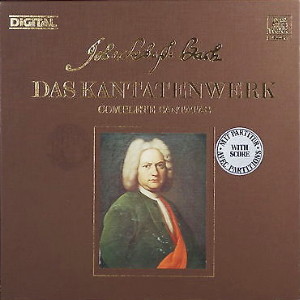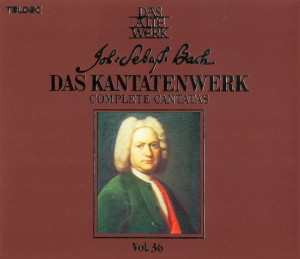 |
|
2 LPs
- 6.35654 EX - (p) 1985
|
 |
| 2 CDs -
8.35654 ZL - (p) 1985 |
|
| DAS KANTATENWERK - Volume 36 |
|
|
|
|
|
|
|
| Johann Sebastian
BACH (1685-1750) |
Kantate
"Man singet mit Freuden vom Sieg",
BWV 149
|
|
19' 22" |
|
|
Kantate
am Michaelisfesttag (Festo Michaelis)
|
|
|
|
|
Text:
Picander III (Jg. 1728/29) und Vierte
Auflage; 1. Psalm 118,15-16; 7. Martin
Schalling 1571 |
|
|
|
|
Solo:
Sopran, Alt, Tenor, Baß - Chor; Tromba
I-III; Timpani; Pbpe I-III; Fagotto;
Streicher; Basso continuo (Violoncello,
Violone, Organo)
|
|
|
|
|
- 1.
Chor: "Man singet mit Freuden vom Sieg"
|
4' 26" |
|
C1 |
|
- 2.
Aria (Basso): "Kraft und Stärke sei
gesungen" |
2' 51" |
|
C2 |
|
- 3.
Recitativo (Alto): "Ich fürchte mich vor
tausend Feinden nicht" |
0' 41" |
|
C3 |
|
- 4.
Aria (Soprano): "Gottes Engel weichen nie" |
5' 15" |
|
C4 |
|
- 5.
Recitativo (Tenore): "Ich danke dir, mein
lieber Gott" |
0' 34" |
|
C5 |
|
- 6.
Aria (Alto, Tenore): "Seid wachsam, ihr
heiligen Wächter" |
3' 28" |
|
C6 |
|
- 7.
Choral: "Ach Herr, laß dein lieb Engelein"
|
2' 39" |
|
C7 |
|
|
|
|
|
|
Kantate
"Nach dir, Herr, verlanget mich",
BWV 150 |
|
15' 28" |
|
|
Ohne
Bestimmung
|
|
|
|
|
Textdichter
unbekannt; 2. Psalm 25,1-2; 4. Psalm 25,5;
6. Psalm 25,15 |
|
|
|
|
Solo:
Sopran, Alt, Tenor, Baß - Chor; Fagotto;
Violino I, II; Basso continuo
(Violoncello, Violone, Organo) |
|
|
|
|
- 1.
Sinfonia |
1' 26" |
|
C8 |
|
- 2.
Chor: "Nach dir, Herr, verlanget mich" |
3' 45" |
|
C9 |
|
- 3.
Aria (Soprano): "Doch bin und bleibe ich
vergnügt" |
1' 23" |
|
C10 |
|
- 4.
Chor: "Leite mich in deiner Wahrheit" |
1' 50" |
|
C11 |
|
- 5.
Aria (Alto, Tenore, Basso): "Zedern müssen
von den Winden" |
1' 29" |
|
D1 |
|
- 6.
Chor: "Meine Augen sehen stets zu dem
Herrn" |
2' 16" |
|
D2 |
|
- 7.
Chor: "Meine Tage in dem Leide" |
3' 07" |
|
D3 |
|
|
|
|
|
|
Kantate
"Süßer Trost, mein Jesus kömmt", BWV
151 |
|
16' 17" |
|
|
Kantate
am 3. Weihnachtsfesttag (Feria 3
Nativitatis Christi) |
|
|
|
|
Text:
Lehms 1711; 5. Nikolaus Herman 1560 |
|
|
|
|
Solo:
Sopran, Alt, Tenor, Baß - Chor; Flauto
traverso; Oboe d'amore; Streicher; Basso
continuo (Violoncello, Violone, Organo) |
|
|
|
|
- 1.
Aria (Soprano): "Süßer Trost, mein Jesus,
kömmt" |
7' 52" |
|
D4 |
|
- 2.
Recitativo (Basso): "Erfreue dich, mein
Herz" |
1' 00" |
|
D5 |
|
- 3.
Aria (Alto): "In Jesu Demut kann ich
Trost" |
5' 52" |
|
D6 |
|
- 4.
Recitativo (Tenore): "Du teurer
Gottessohn" |
0' 46" |
|
D7 |
|
- 5.
Choral: "Heut schleußt er wieder auf die
Tür" |
0' 35" |
|
D8 |
|
|
|
|
|
Sebastian
Hennig (Solist des Knabenchores
Hannover), Sopran (BWV 149, 151)
Ansgar Pfeiffer (Solist des Knabenchores
Hannover), Sopran (BWV 150)
Paul Esswood, Alt
Kurt Equiluz, Tenor
Max van Egmond, Baß
Knabenchor Hannover |
Heinz Hennig, Leitung
Collegium Vocale Gent | Philippe
Herreweghe, Leitung
Das verstärkte LEONHARDT-CONSORT mit
Originalinstrumenten
- Ricardo Kanji, Traverflöte
- Friedemann Immer, Kay Immer, Hans-Jörg
Packeiser, Trompeten
- Ku Ebbinge (BWV149/1,5,7; 151/4), Bruce
Haynes, Pieter Dhont (BWV 149/1,7), Oboe
- Marie Leonhardt, Lucy van
Dael (BWV149/5; 151/4), Alda Stuurop,
Antoinette van den Hombergh, Marcel Destubé,
Violinen
- Staas Swiestra, Ruth Hesseling, Viola
- Frans R. Berkhout, Fagotto
- Wouter Möller (BWV 149/1,3-7; 150;
151/1,3-5),Richte van der Meer (BWV 149/6),
Lindewij Schijfes, Violoncello
- Anthony Woodrow, Violone
- Nick Wood, Timpani
- Gustav Leonhardt (BWV 149/5; 151/4), Bob
van Asperen, Orgel
Gustav Leonhardt, Gesamtleitung
|
|
|
|
|
Luogo
e data di registrazione |
|
Doopsgezinde Kerk,
Haarlem (Holland) - Gennaio 1984
|
|
|
Registrazione: live
/ studio |
|
studio |
|
|
Producer |
|
Wolf Erichson
|
|
|
Prima Edizione LP |
|
Teldec "Das Alte
Werk" | 6.35654 EX | 2 LPs -
durata 49' 24" - 51' 33" | (p)
1985 | DIGITAL DMM
|
|
|
Edizione CD |
|
Teldec Classics |
LC 6706 | 8.35654 ZL | 2 CDs -
durata 49' 24" - 51' 33" | (p)
1985 | DDD |
|
|
Cover
|
|
Johann Sebastian
Nach, einige Jahre vor seiner
Ernennung zum Kantor in Leipzig.
Gemälde con JJ. Ihle (1720) Bach
Museum Eisenach.
|
|
|
Note |
|
In questo volume sono
presenti anche La Cantate BWV 147
e BWV 148 a cura del Concentus
Musicus Wien diretto da Nikolaus
Harnoncourt.
|
|
|
|
|
INTRODUCTION
by Gerhard Schuhmacher
»Man singet mit Freuden
vom Sieg« (BWV 149),
written for the Feast of St.
Michael, is based on a text
by Picander of 1728. The
Saint’s victory over Satan
inspired Bach to borrow the
final movement of the
Hunting Cantata, BWV 208,
for the opening chorus. The
two hunting horns were
replaced by three heraldic
trumpets and timpani,
otherwise the scoring was
left intact. The
transposition from F to D,
although in accordance with
character and tuning of the
instruments, resulted in the
»feel« of the movement being
altered. Apart from the
general resemblance in mood,
words of similar meaning or
derived from the same root,
e. g. »freudige Stunden«
(»joyful hours«) replacing
the earlier »Mit Freuden«
(»joyfully«), provided the
material for an adequate
setting of the text in
addition to an effective
»parody«. The instrumental
and vocal figuration of the
bass aria (No. 2) reveal a
vision of apocalyptic power,
in contrast to the dancing
soprano aria »Gottes Engel
weichen nie« (»God’s angels
never leave me«) which is a
tone picture of security. In
the duet »Seid wachsam, ihr
heiligen Wächter« (»Be
vigilant, ye holy watchmen«)
a bassoon, otherwise hardly
ever used by Bach as a solo
instrument, represents the
sentinels on their rounds. A
simple chorale concludes the
cantata, with the trumpets
entering quite unexpectedly
at the end.
»Nach dir, Herr,
verlanget mich, (BWV 150),
being written for an
unspecified occasion, has
often had its authenticity
called in question. However,
certain features, such as
the brief Sinfonia, the
scoring and its resemblance
to other works suggest that
it was composed in 1708/09.
The choral movements (Nos. 2
and 4) are structured in
short passages in the style
of a motet, No. 4 »Leite
mich« (»Lead me«), in which
the voices take over from
one another, containing
remarkable word painting.
The choral movement »Meine
Augen sehen stets zu dem
Herrn« (»My eyes always look
to the Lord«) is in two
sections, the first one
acting as a prelude to the
fugue which follows. The
final movement is a Ciacona,
a form derived from purely
instrumental music, which so
impressed Johannes Brahms
when the complete edition of
Bach’s works was published
in 1844 that he used the
bass line, with slight
modifications, for the last
movement of his Fourth
Symphony, which is also a
Chaconne.
»Süßer Trost, mein Jesu
kömmt« (BWV 151), set
to a text by the Darmstadt
poet Georg Christian Lehms,
was written for the third
day of Christmas. As in
other cantatas for the third
day of a feast, Bach only
used the choir of St.
Thomas’s, who had been hard
at work, in the simple
chorale. The opening aria,
which has been particularly
highly regarded ever since
it became known in the 19th
century, dominates and casts
a glow over the whole work.
The tension between inner
joy and consolation, the
molto adagio and sempre
piano of the first part, and
the vivace of the central
section create an
espressivo, the polarities
of which Bach usually
allotted to two separate
arias (e. g. in BWV 147-
149). Here the spacious
melodic phrases and tone
colours evocative of chamber
music (woodwind and strings)
determine its intimate
character, which carries
over into the alto aria. The
symbolism of the two
recitatives matches the
expressive lines of the
arias.
|
  |
|
|